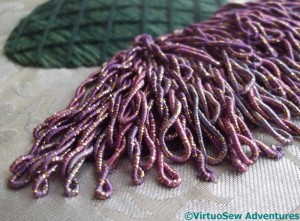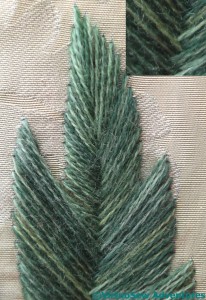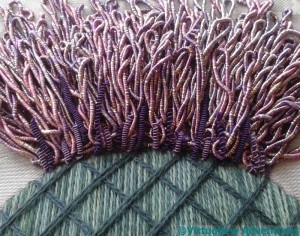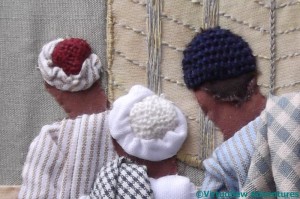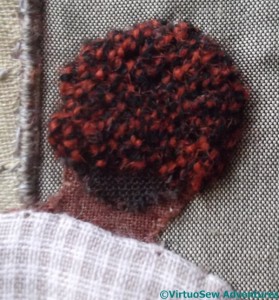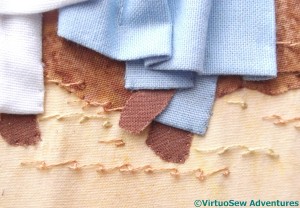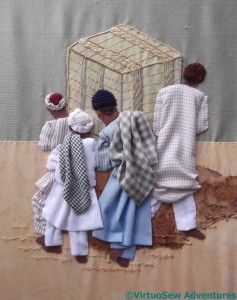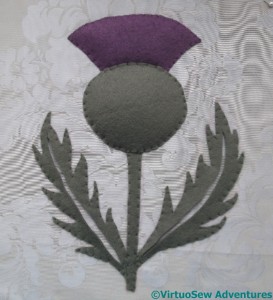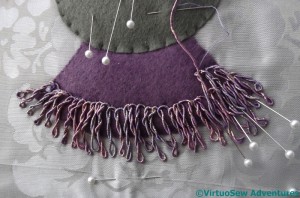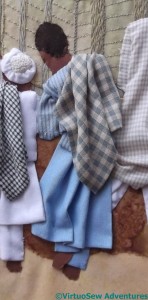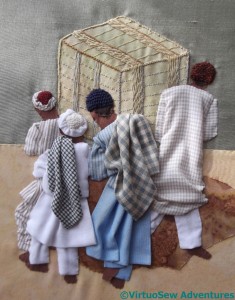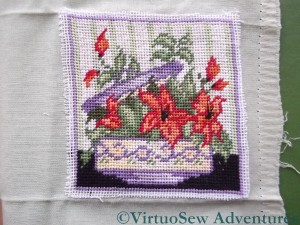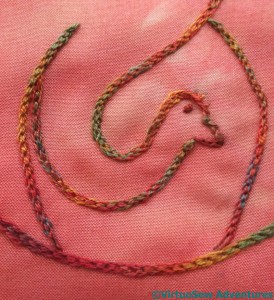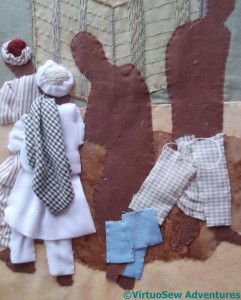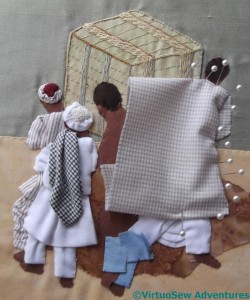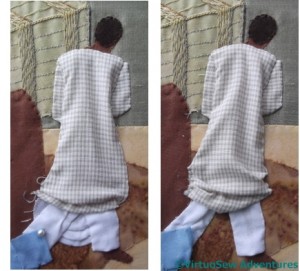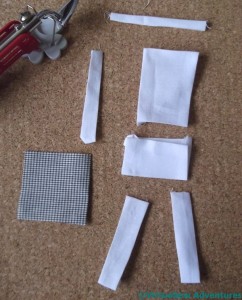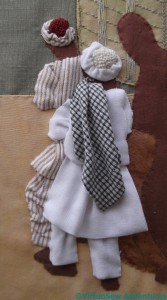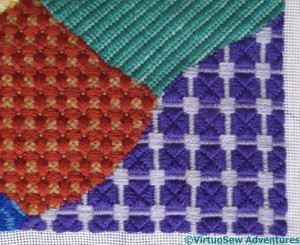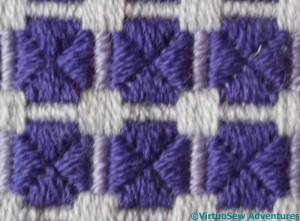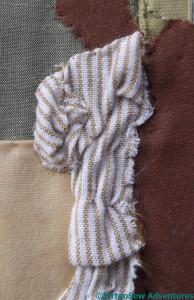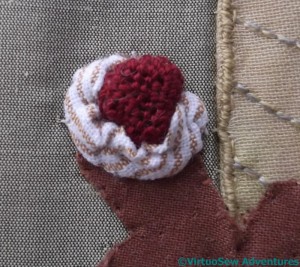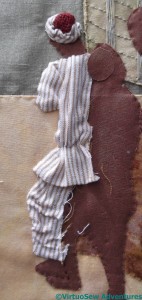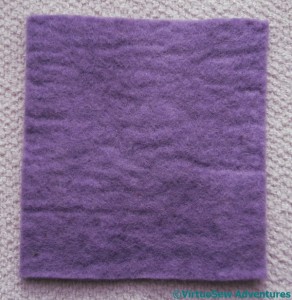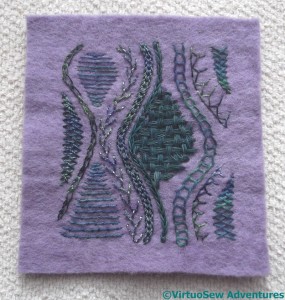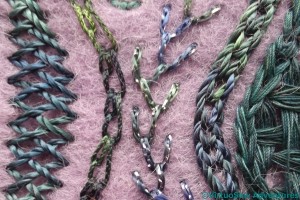About Rachel
View all posts by Rachel
Progress on the Thistle
I rather like the texture of the layers and layers of viscose gimp, in this photo. Every now and then an oblique view is exactly the right one, and it’s a gorgeously over-the-top effect, isn’t it!
I did find myself beginning to feel rather tied in knots by all the twisting and turning, and progress slowed noticeably as the number of layers increased and the difficulty of holding the strands just firmly enough also increased.
Worth it, though, I think!
The leaves required some slightly careful management. I wanted to use fishbone stitch, because I wanted a simple leaf so as not to detract too much from the flower. However, fishbone stitch does use rather a lot of thread, and I was just a little nervous about whether I would have enough of my lovely wool to do the job.
So I thought, first of all, that I would use the light and medium shades together. They aren’t flat, solid colour; they shade a little either side of the main colour, and this brings a little variation to what might otherwise have been a somewhat monolithic element.
Then, secondly, instead of taking the thread across the back from side to side, I devised a variation which changed slightly the pattern of the crossing in the centre. You can see in the detail in the top right hand corner, that there are two sets of threads in each section. There are only small back stitches running down the outside edges, and down the vein in the middle, so the amount of thread on the back has been minimised.
I originally hoped to use the layers and layers of viscose gimp as the base for another layer, of silk wrapped pearl purl, and of coloured wire purl.
Unfortunately, when I’d done it, I decided that I really didn’t like it at all.
It adds nothing to the design, and in fact, it even detracts from it. Out, out, out!
So having taken it out, rather grumpily, I sat back to consider whether or not I have finished the piece at all….
Final Details on Loading The Felucca – for now!
Both of the labourers on the right have a small piece of dark brown cotton attached to their heads to give the impression of hair.
Two of the hats (the ones on the right) are turban-like things with a central section and a twist of fabric, and you’ve seen them before. They were really very successful, but the other two labourers seem to be wearing knitted or crocheted caps. Somehow trellis stitch didn’t seem quite right, so in this case I’ve used detached buttonhole stitch with return, in navy blue pearl cotton.
The final hat is much woollier. I used a heathered worsted yarn and trellis stitch. I have a few doubts about this one, but for now I’m content with it.
I was concerned that the dark cotton and the light background cotton were too distinct, and made too much of a contrast. My first efforts to break up the surfaces were not as successful as they might have been, but in due course I arrived at the solution – rows of scroll stitch using a single strand of thread, in tones that lie between the two extremes.
I’ve left the little foot unattached, dangling over the sandy surface and seeming to poke out of the trouser leg just as it should.
And behold the (nearly) final version.
I think there is just enough of the scroll stitch, and the packing case has almost the right level of detail to make sense, but not so much as to attract more attention than it should. The people have worked, if anything, even better than I hoped they would.
I’m going to wait until I know where in the Dreams of Amarna the piece is going to live – either as a patch on one of the main panels, or as a stand-alone, separate panel – before I do any more. At the moment, I don’t know what more to do, or how to do it, and until I do know, I’m not risking the success I’ve already had.
An Experimental Thistle
After I’d (mostly) finished Loading The Felucca, I found myself temporarily lacking inspiration for the Dreams of Amarna, so I thought I’d have a go at an idea that has been burbling around in the back of my mind for a while. I’m hoping a change of scene, as it were, will “reboot” my imagination.
The background fabric is a silk brocade, and I’ve padded the thistle itself with wool felt, in several layers (three under the topmost green circle, in fact).
I drew the whole thing freehand, and I think I will remove and replace the lefthand leaf with a reversed version of the righthand leaf. It will look more balanced and altogether happier if I do.
I’m intending to use silk purl and coloured wire purl for the thistle flower, but I wanted something for those to be embedded in. I’ve chosen to use a gold and viscose gimp, and I’m couching it down in a series of fringes zigzagging across the flower.
Each fringe is twisted back on itself – I used a pin as a sort of handle – and held down with small stitches at each end. As each additional layer went on, the “free” ends were held down a little less firmly. It’s a delicate balance between controlling the thread sufficiently (and remember gimps are very stiff and have a mind of their own!) and leaving it looking free and springy!
The Fourth Labourer
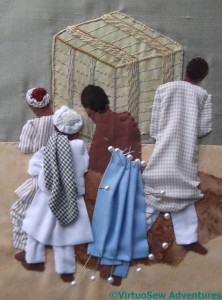 Finally, after all that trouble with the Third Labourer, I moved on to the fourth.
Finally, after all that trouble with the Third Labourer, I moved on to the fourth.
After some playing around with colours, I decided to dye some of the fabrics I’d bought to clothe these fellows (Bahama Blue, if anyone wants to know!). It proved to me that some of the fabrics which I had expected to be cotton weren’t, but that doesn’t matter in this context. This project is going to be a positive riot of different materials!
You can see that I made considerable use of pins to control the fabric and keep the pleats in something resembling order, holding the fabric to be ironed, and simply leaving it while I thought about the next stage.
The stripy fabric for this fellow’s shirt is the same as the stripes on the first one, overdyed with the blue, and the bold blue check was overdyed with a stony beige colour, to try to make it look a little dusty. It barely made any difference, but sometimes “barely” is good enough.
I’m very pleased with the way the folds suggest the raised leg, and the turned in sections of the tunic create some bulk for the shoulders.
And, though I say it myself, I think the folds of the shawl (if that’s what it is) are an absolute triumph. They are secured in a few places, but I defy you to find the stitches, even if you zoom in on the picture, and I’ve avoided crushing any of folds.
The basic figures are now completed, and I’m really rather pleased with how they’ve turned out, but I do feel as though there may be some details missing.
More staring and thinking required…
More Unfinished Objects
I keep on finding things that I’ve not quite finished, don’t I – and in some cases I had completely forgotten about them.
Like this one. I know it was a kit – stranded cotton worked in half-cross stitch on canvas, – but I don’t know why I bought it.
And I clearly had something in mind for it, because I have attached it to a cotton furnishing fabric. Equally clearly, it wasn’t going to be a cushion centre, or I would have centred it on the fabric. It is only about three inches square, so I suspect I had in mind making it into a needlecase.
But before I do anything else with it, I have to find some way of covering those raw edges of canvas with something that looks deliberate!
Any suggestions?
In other news, though – I’ve finished the second Crane!
Actually, you may recall that it was the first, but I decided it looked too overheated in the pot it was destined for, and set it aside for another version.
I found in when I was looking for something else, and finished it. At least, the embroidery…
I will probably mount it on a circle of card, and put in that famed Winter Decoration corner.
At least I know what I’m going to do with this one!
The Third Labourer
The mini-iron has been very helpful in turning and pressing the edges of the fabric pieces – sometimes before they’re applied, and sometimes afterwards, but at first I was very surprised to find myself wielding it left-handedly, more often than not. Then a little further thought, and it made sense – the difficult part is controlling the fabric, so naturally I would use my better hand.
First of all I started on the middle figure, forgetting that he is the nearest to the camera. So I stopped working on him – leaving his trouser bottoms in place – and moved on to the figure on the right.
Then the pleated drape cause me a great deal of trouble. Then I wasn’t sure about the left leg. Then I realised that I’d used the checked fabric I was intending for the overshirt.
More unpicking. Grr!
I reinstated the trousers and the drapery in white fabric and then started trying to fit the overshirt.
I’ve been making extensive use of that set of pins that Karen Ruane sent me (thank you again, Karen – they’ve been invaluable!) as I try to work out how to make the overshirt sit properly.
In this case, however, having pinned and stitched, and unpicked and pressed and restitched, I decided I still had some reservations.
Still more unpicking.
Grr yet again!
So after much more puzzling and unpicking and re-stitching, I think I’m happier now. I’ve reduced the bulk in the left shoulder, removed the drapery, which is in the photo but didn’t “read” well in the applique, and reworked the overshirt.
Again.
None of the lower edges have been caught down, which I hope will help create the proper effect of garments that can move around a body. That does mean, of course, that I will have to be very careful not to crush the final piece when I’m storing it, but I do think it will be worth the effort!
Dressing the Second Labourer
Since I decided after dressing the first labourer that using rectangles of fabric was the way to go, when I started on the second I began by cutting out every bit that I expected to need.
That meant:
two pieces for the legs, a piece for the body of the top, a piece for the section of the top below the waist, a piece for the turban, a piece for the sleeve, and a piece for the cloth thrown over the shoulder.
I bought myself a mini-iron to make the job of folding in the edges easier, lighter, and less perilous. Fortunately there are two more labourers to dress, so I will have plenty of time to improve my skill!
The trick to a successful applique is the order in which the elements are layered.
So in this case, the first pieces are the trousers. They are stitched down each side, and tweaked in the middle to create some impression of a body underneath. The bottom edges aren’t held down, so in storage this piece may be a bit delicate.
The turban is done in just the same way as the first one, but this time I used a cream linen thread for the central disc.
The sleeve was next, and then the “skirt” of the top, which is gathered to give it a sense of bulk. It is tethered by the underlayer, but not attached at the bottom edge. The right-hand edge isn’t tethered, either, because in due course the Third Labourer’s clothing needs to fit underneath..
Finally, there was the body of the top, and the fabric thrown over the shoulder. I don’t understand why he didn’t use it to pad his shoulder against the packing case, but the photo says he didn’t!
Dressing the First Labourer
Having stared thoughtfully at the people, I cut out some clothing shapes out of one of my pieces of quilting cotton, and started trying to create folds in them as I attached them to the fabric.
The trousers were tricky, but not impossibly so. The jacket, or top, or whatever it is, brought me to an abrupt halt.
Dearie, dearie me.
That didn’t work at all, did it.
The bulk and the folds are all in the wrong places. He’s certainly crumpled, but it isn’t the right sort of crumpled! And don’t even get me started on how difficult it was. I felt as though I was all fingers and thumbs – it was almost as bad as working with glue!
Cue much muttering, unpicking, and rethinking.
While I was thinking, I had a go at the turban.
The textured deep crimson is a circle of trellis stitch, a densely knotted needlelace stitch I’ve used a lot in my various Thistle Threads courses. The thread is silk, from a bag of “odds and ends” from Mulberry Silks. I cut out a circle of the fabric I’d stitched and gathered it to create a crimson bobble.
The cotton around it is a narrow tube of the fabric I was using, tucked under the crimson bobble at either end, and held down with odd little stitches to create the effect of folds.
That worked. It also gave me a thought. There seems to be very little shaping in the garments we see in the photos from the dig – not least, in such a hot climate, loose, airy, voluminous clothing is likely to be a lot more comfortable!
So the next version of the labourer’s clothing was made, essentially, by cutting out a series of rectangles and applying them separately. In this case, there was only one rectangle for the sleeve, and then another for the body. It’s been gathered in to create a loosely bloused waist, and left flat and unfinished on the inner side where it will be covered by the next labourer’s clothing.
I think this has worked a great deal better. I might even be able to bring my imagined picture almost fully to life!
I’ve also added another layer for the face of the second labourer. There won’t be much of it visible, but the first labourer’s clothes are supposed to be behind it, so the addition was necessary.
More Experiments!
You could be forgiven for thinking that I had finally lost all common sense. We’re all interested in fibre, fabric, and stitch, but even so, expecting you to take an interest in a photograph of a plain piece of felt seems a little extreme.
Especially a very ordinary, single-colour, and entirely unadorned piece of felt.
So what am I up to?
Mischief, of course!
Does it help if I tell you that it’s really quite a thick piece of felt?
Or does it help if I tell you that this is the front?
I bought an “inspiration pack” of threads, and this thick square of felt at “Sewing For Pleasure” a while back, with absolutely no idea of what I expected or intended to do with it.
While I was wondering about it, I remembered reading about a medieval satchel that had been made by sewing the pieces together within the thickness of the leather. I didn’t feel quite willing to attempt something structural, but it gave me the idea of trying to work a sampler of stitches without the back showing.
I even managed to work some of my favourite stitches.
I originally began with a wavy line of Shell Chain stitch, and then built up the design from there. Some of the threads were too heavy to use in this context, and there was a wonderful heavy slub that I couldn’t find a use for (never fear, I will!) but I had great fun alternating texture and shine, space-filling and line, and just playing.
I have absolutely no idea what I’m going to do with it, but I’m rather pleased with how it turned out!

